Opportunity to present practitioner views on new dredging science
Shark Bay: A World Heritage Site at catastrophic risk
By : Matthew Fraser, University of Western Australia; Ana Sequeira, University of Western Australia; Brendan Paul Burns, UNSW; Diana Walker, University of Western Australia; Jon C. Day, James Cook University, and Scott Heron, James Cook University
The devastating bleaching on the Great Barrier Reef in 2016 and 2017 rightly captured the world’s attention. But what’s less widely known is that another World Heritage-listed marine ecosystem in Australia, Shark Bay, was also recently devastated by extreme temperatures, when a brutal marine heatwave struck off Western Australia in 2011.
A 2018 workshop convened by the Shark Bay World Heritage Advisory Committee classified Shark Bay as being in the highest category of vulnerability to future climate change. And yet relatively little media attention and research funding has been paid to this World Heritage Site that is on the precipice.
Shark Bay, in WA’s Gascoyne region, is one of 49 marine World Heritage Sites globally, but one of only four of these sites that meets all four natural criteria for World Heritage listing. The marine ecosystem supports the local economy through tourism and fisheries benefits.
Around 100,000 tourists visit Shark Bay each year to interact with turtles, dugongs and dolphins, or to visit the world’s most extensive population of stromatolites – stump-shaped colonies of microbes that date back billions of years, almost to the dawn of life on Earth.
Commercial and recreational fishing is also extremely important for the local economy. The combined Shark Bay invertebrate fishery (crabs, prawns and scallops) is the second most valuable commercial fishery in Western Australia.
Under threat
However, this iconic and valuable marine ecosystem is under serious threat. Shark Bay is especially vulnerable to future climate change, given that the temperate seagrass that underpins the entire ecosystem is already living at the upper edge of its tolerable temperature range. These seagrasses provide vital habitat for fish and marine mammals, and help the stromatolites survive by regulating the water salinity.
Stromatolites are a living window to the past. Matthew Fraser
Shark Bay received the highest rating of vulnerability using the recently developed Climate Change Vulnerability Index, created to provide a method for assessing climate change impacts across all World Heritage Sites.
In particular, extreme marine heat events were classified as very likely and predicted to have catastrophic consequences in Shark Bay. By contrast, the capacity to adapt to marine heat events was rated very low, showing the challenges Shark Bay faces in the coming decades.
The region is also threatened by increasingly frequent and intense storms, and warming air temperatures.
To understand the potential impacts of climatic change on Shark Bay, we can look back to the effects of the most recent marine heatwave in the area. In 2011 Shark Bay was hit by a catastrophic marine heatwave that destroyed 900 square kilometres of seagrass – 36% of the total coverage.
This in turn harmed endangered species such as turtles, contributed to the temporary closure of the commercial crab and scallop fisheries, and released between 2 million and 9 million tonnes of carbon dioxide – equivalent to the annual emissions from 800,000 homes.
Read more: Climate change threatens Western Australia’s iconic Shark Bay
Some aspects of Shark Bay’s ecosystem have never been the same since. Many areas previously covered with large, temperate seagrasses are now bare, or have been colonised by small, tropical seagrasses, which do not provide the same habitat for animals. This mirrors the transition seen on bleached coral reefs, which are taken over by turf algae. We may be witnessing the beginning of Shark Bay’s transition from a sub-tropical to a tropical marine ecosystem.
This shift would jeopardise Shark Bay’s World Heritage values. Although stromatolites have survived for almost the entire history of life on Earth, they are still vulnerable to rapid environmental change. Monitoring changes in the microbial makeup of these communities could even serve as a canary in the coalmine for global ecosystem changes.
The neglected bay?
Despite Shark Bay’s significance, and the seriousness of the threats it faces, it has received less media and funding attention than many other high-profile Australian ecosystems. Since 2011, the Australian Research Council has funded 115 research projects on the Great Barrier Reef, and just nine for Shark Bay.
Coral reefs rightly receive a lot of attention, particularly given the growing appreciation that climate change threatens the Great Barrier Reef and other corals around the world.
The World Heritage Committee has recognised that local efforts alone are no longer enough to save coral reefs, but this logic can be extended to other vulnerable marine ecosystems – including the World Heritage values of Shark Bay.
Safeguarding Shark Bay from climate change requires a coordinated research and management effort from government, local industry, academic institutions, not-for-profits and local Indigenous groups – before any irreversible ecosystem tipping points are reached. The need for such a strategic effort was obvious as long ago as the 2011 heatwave, but it hasn’t happened yet.
Read more: Marine heatwaves are getting hotter, lasting longer and doing more damage
Due to the significant Aboriginal heritage in Shark Bay, including three language groups (Malgana, Nhanda and Yingkarta), it will be vital to incorporate Indigenous knowledge, so as to understand the potential social impacts.
And of course, any on-the-ground actions to protect Shark Bay need to be accompanied by dramatic reductions in greenhouse emissions. Without this, Shark Bay will be one of the many marine ecosystems to fundamentally change within our lifetimes.
Matthew Fraser, Postdoctoral Research Fellow, University of Western Australia; Ana Sequeira, ARC DECRA Fellow, University of Western Australia; Brendan Paul Burns, Senior Lecturer, UNSW; Diana Walker, Emeritus Professor, University of Western Australia; Jon C. Day, PSM, Post-career PhD candidate, ARC Centre of Excellence for Coral Reef Studies, James Cook University, and Scott Heron, Senior Lecturer, James Cook University
This article is republished from The Conversation under a Creative Commons license. Read the original article.
Shark Bay: A World Heritage Site at catastrophic risk
The devastating bleaching on the Great Barrier Reef in 2016 and 2017 rightly captured the world’s attention. But what’s less widely known is that another World Heritage-listed marine ecosystem in Australia, Shark Bay, was also recently devastated by extreme temperatures, when a brutal marine heatwave struck off Western Australia in 2011.
A 2018 workshop convened by the Shark Bay World Heritage Advisory Committee classified Shark Bay as being in the highest category of vulnerability to future climate change. And yet relatively little media attention and research funding has been paid to this World Heritage Site that is on the precipice.
Read more: Shark Bay stromatolites at risk from climate change
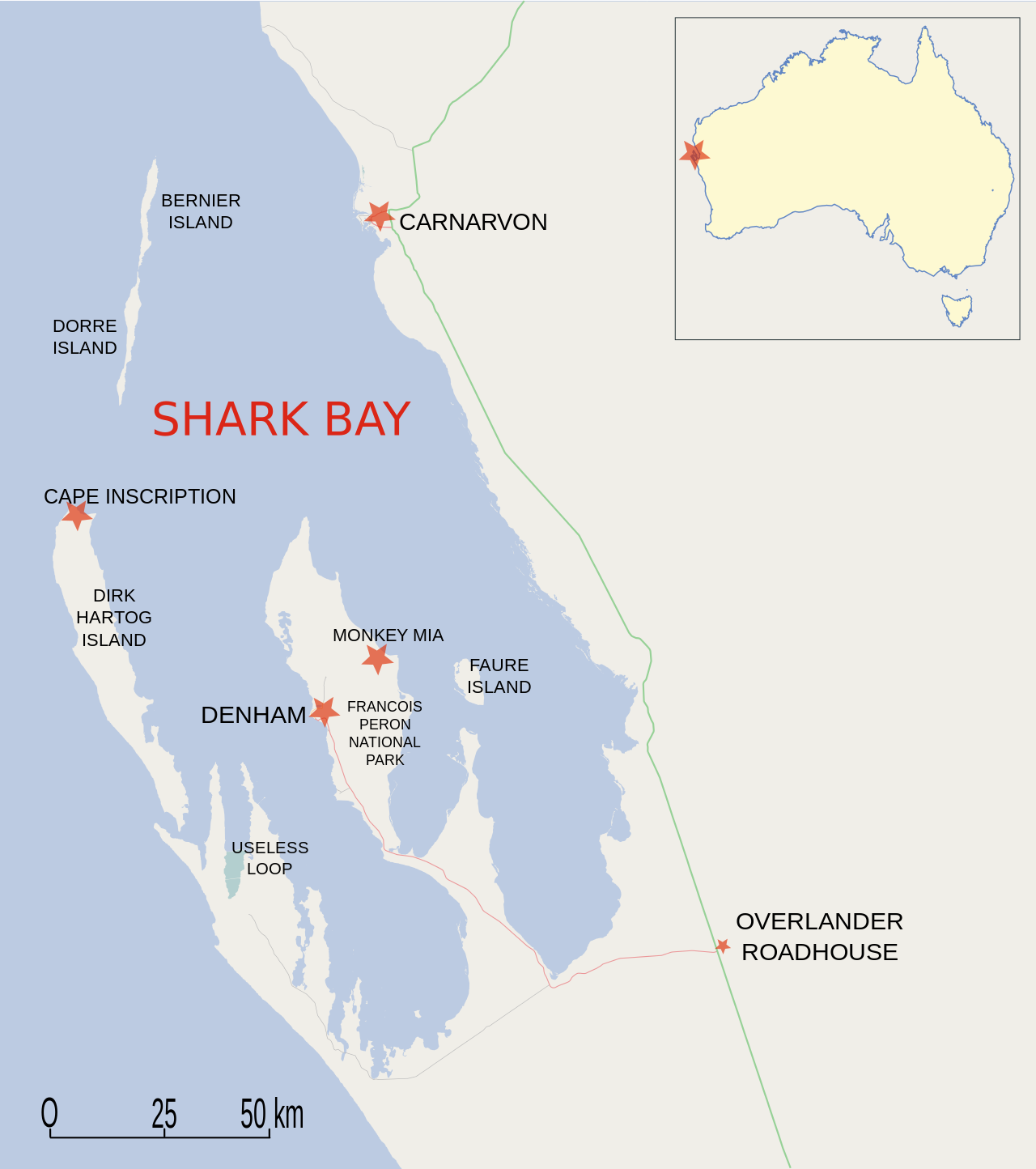
Shark Bay, in WA’s Gascoyne region, is one of 49 marine World Heritage Sites globally, but one of only four of these sites that meets all four natural criteria for World Heritage listing. The marine ecosystem supports the local economy through tourism and fisheries benefits.
Around 100,000 tourists visit Shark Bay each year to interact with turtles, dugongs and dolphins, or to visit the world’s most extensive population of stromatolites – stump-shaped colonies of microbes that date back billions of years, almost to the dawn of life on Earth.
Commercial and recreational fishing is also extremely important for the local economy. The combined Shark Bay invertebrate fishery (crabs, prawns and scallops) is the second most valuable commercial fishery in Western Australia.
Under threat
However, this iconic and valuable marine ecosystem is under serious threat. Shark Bay is especially vulnerable to future climate change, given that the temperate seagrass that underpins the entire ecosystem is already living at the upper edge of its tolerable temperature range. These seagrasses provide vital habitat for fish and marine mammals, and help the stromatolites survive by regulating the water salinity.

Shark Bay received the highest rating of vulnerability using the recently developed Climate Change Vulnerability Index, created to provide a method for assessing climate change impacts across all World Heritage Sites.
In particular, extreme marine heat events were classified as very likely and predicted to have catastrophic consequences in Shark Bay. By contrast, the capacity to adapt to marine heat events was rated very low, showing the challenges Shark Bay faces in the coming decades.
The region is also threatened by increasingly frequent and intense storms, and warming air temperatures.
To understand the potential impacts of climatic change on Shark Bay, we can look back to the effects of the most recent marine heatwave in the area. In 2011 Shark Bay was hit by a catastrophic marine heatwave that destroyed 900 square kilometres of seagrass – 36% of the total coverage.
This in turn harmed endangered species such as turtles, contributed to the temporary closure of the commercial crab and scallop fisheries, and released between 2 million and 9 million tonnes of carbon dioxide – equivalent to the annual emissions from 800,000 homes.
Read more: Climate change threatens Western Australia’s iconic Shark Bay
Some aspects of Shark Bay’s ecosystem have never been the same since. Many areas previously covered with large, temperate seagrasses are now bare, or have been colonised by small, tropical seagrasses, which do not provide the same habitat for animals. This mirrors the transition seen on bleached coral reefs, which are taken over by turf algae. We may be witnessing the beginning of Shark Bay’s transition from a sub-tropical to a tropical marine ecosystem.
This shift would jeopardise Shark Bay’s World Heritage values. Although stromatolites have survived for almost the entire history of life on Earth, they are still vulnerable to rapid environmental change. Monitoring changes in the microbial makeup of these communities could even serve as a canary in the coalmine for global ecosystem changes.
The neglected bay?
Despite Shark Bay’s significance, and the seriousness of the threats it faces, it has received less media and funding attention than many other high-profile Australian ecosystems. Since 2011, the Australian Research Council has funded 115 research projects on the Great Barrier Reef, and just nine for Shark Bay.
Coral reefs rightly receive a lot of attention, particularly given the growing appreciation that climate change threatens the Great Barrier Reef and other corals around the world.
The World Heritage Committee has recognised that local efforts alone are no longer enough to save coral reefs, but this logic can be extended to other vulnerable marine ecosystems – including the World Heritage values of Shark Bay.
Safeguarding Shark Bay from climate change requires a coordinated research and management effort from government, local industry, academic institutions, not-for-profits and local Indigenous groups – before any irreversible ecosystem tipping points are reached. The need for such a strategic effort was obvious as long ago as the 2011 heatwave, but it hasn’t happened yet.
Read more: Marine heatwaves are getting hotter, lasting longer and doing more damage
Due to the significant Aboriginal heritage in Shark Bay, including three language groups (Malgana, Nhanda and Yingkarta), it will be vital to incorporate Indigenous knowledge, so as to understand the potential social impacts.
And of course, any on-the-ground actions to protect Shark Bay need to be accompanied by dramatic reductions in greenhouse emissions. Without this, Shark Bay will be one of the many marine ecosystems to fundamentally change within our lifetimes.![]()
Matthew Fraser, Postdoctoral Research Fellow, University of Western Australia; Ana Sequeira, ARC DECRA Fellow, University of Western Australia; Brendan Paul Burns, Senior Lecturer, UNSW; Diana Walker, Emeritus Professor, University of Western Australia; Jon C. Day, PSM, Post-career PhD candidate, ARC Centre of Excellence for Coral Reef Studies, James Cook University, and Scott Heron, Senior Lecturer, James Cook University
This article is republished from The Conversation under a Creative Commons license. Read the original article.
Opportunity to present practitioner views on new dredging science
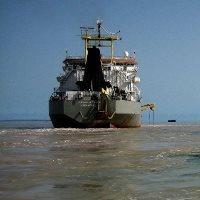
Impact prediction, monitoring and the lessons learnt from implementing dredging programs is the focus for discussion led by the Western Australian Marine Science Institution (WAMSI) at the AMSA Conference in July.
The “Perspectives on Dredging” symposium co-Chair and WAMSI CEO Dr Luke Twomey said the purpose of the symposium, in Fremantle, is to gain a better understanding of how new knowledge is being put into practice.
“This is an opportunity for us to understand practitioners’ views on the new science that is being produced and how they are likely to use it,” Dr Twomey said.
“From recent mega-projects in Western Australian and Queensland, to small maintenance dredging programs in coastal waterways, this conversation will help to understand how the science outcomes are being put into practice and help to identify the future direction for research.”
Australia has experienced unprecedented levels of dredging over the last two decades and the nation’s biggest single-issue science program to address the science questions, the WAMSI Dredging Science Node, is about to release the synthesis of those results.
“As a result, there have been some incredible advances in our understanding of impacts to the marine environment from dredging and how to better predict, monitor and manage dredging programs,” Dr Twomey said. “The question now is, how are practitioners using those results?”
The “Perspectives on Dredging” AMSA symposium is open to scientists, regulators, resource managers, industry, consultants and those with a practical experience of dredging practices in the marine environment.
It will provide an opportunity for dredging professionals to demonstrate their contemporary practical experience and how the impacts of dredging on the marine environment are predicted, managed and monitored in real-world scenarios.
WAMSI is providing the opportunity for day sponsorship for five student presentations at either the “Perspectives on Dredging” or “The South Coast of Western Australia: research for management” symposia at AMSA.
To be considered please submit your abstract to AMSA by COB Friday 22 February AND email your abstract or any questions to info@wamsi.org.au.
Final call for submissions: Uncovering data about the South Coast of WA
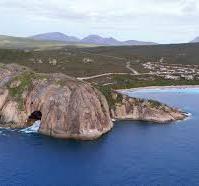
Uncovering the published and unpublished data relating to the economic, social and environmental dimensions of the waters off the south coast is the conversation the Western Australian Marine Science Institution wants to start at this year’s AMSA Symposium in July.
The symposium, in Fremantle, aims to bring the South Coast to the attention of the wider marine science community and government bodies as well as begin to understand the knowledge gaps, impacts and the opportunities.
Symposium Chair and WAMSI Research Director Dr Jenny Shaw explained the purpose is to bring the research together that will help to develop a strong case for a future WAMSI research program to support south coast marine management.
“This is the first step in understanding what knowledge is available ahead of canvassing government, industry, community and research views on management and what’s important to them about the south coast,” Jenny said.
“Previously there has been little focus on the south coast, however, renewed interest in the opportunity for economic development in this pristine environment has meant it’s time to make this area a focus for research.”
This symposium session is open to all researchers working off the south coast of Western Australia and welcomes collaborative input into informing management with good science.
WAMSI is offering day sponsorship for five student presentations at its AMSA symposiums.
To be considered please submit your abstract to AMSA by COB Friday 22 February and also email your abstract or any questions to info@wamsi.org.au.
Stakeholder engagement to deliver science plan for Shark Bay
A comprehensive plan to respond to environmental pressures facing the Shark Bay World Heritage site is being led by the Western Australian Marine Science Institution (WAMSI).
Scientist throughout WA and the world have been rallying to raise the alarm about the demise of the unique environment and popular tourist destination (800 kilometres north of Perth), which has been experiencing environmental changes more rapidly since a marine heatwave in 2011.
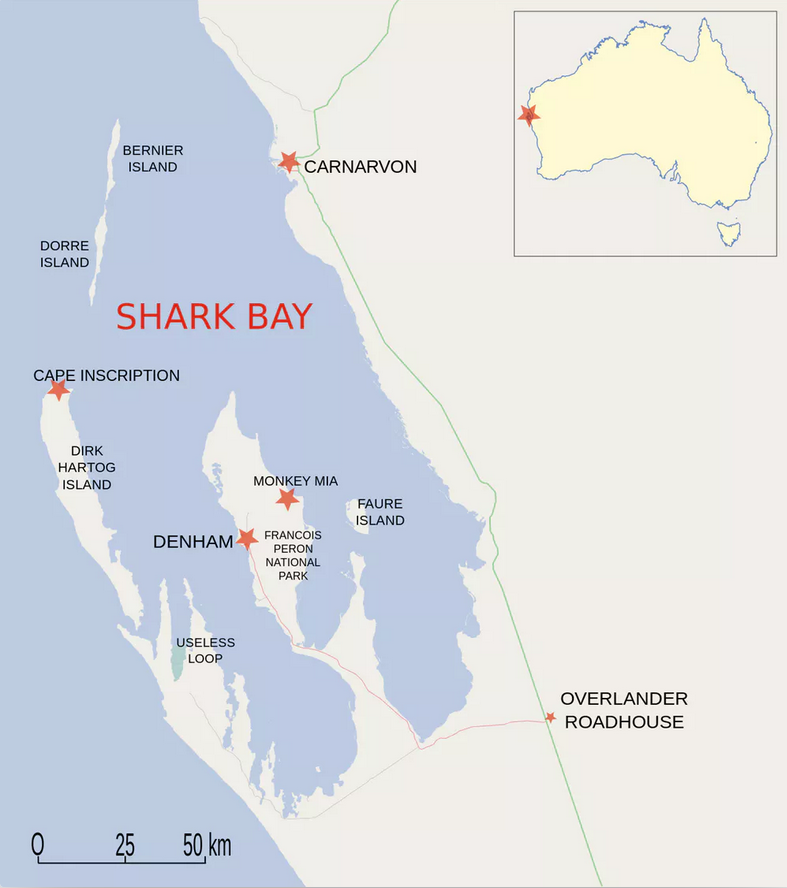
Famous for its abundant marine life including dolphins, dugongs, marine turtles and its rare, ancient stromatolites, the Shark Bay economy also relies on the success of its commercial fishing industry.
WAMSI has announced the start of its review of stakeholder views and science priorities that will determine the best approach for delivering a coordinated response now and into the future.
The stakeholder engagement, led by WAMSI Research Director Dr Jenny Shaw, will take in the views of represented individuals and groups from state and Commonwealth governments, research oganisations, fishers, tourism, conservation, Indigenous and other community stakeholders.
“What we’re trying to understand is the stakeholder issues and opportunities for the Shark Bay area,” Jenny said. “We’ll also conduct a review of the existing knowledge and identify the gaps from the feedback we get from stakeholders. These issues will then be prioritised before we develop a comprehensive Science Plan.”
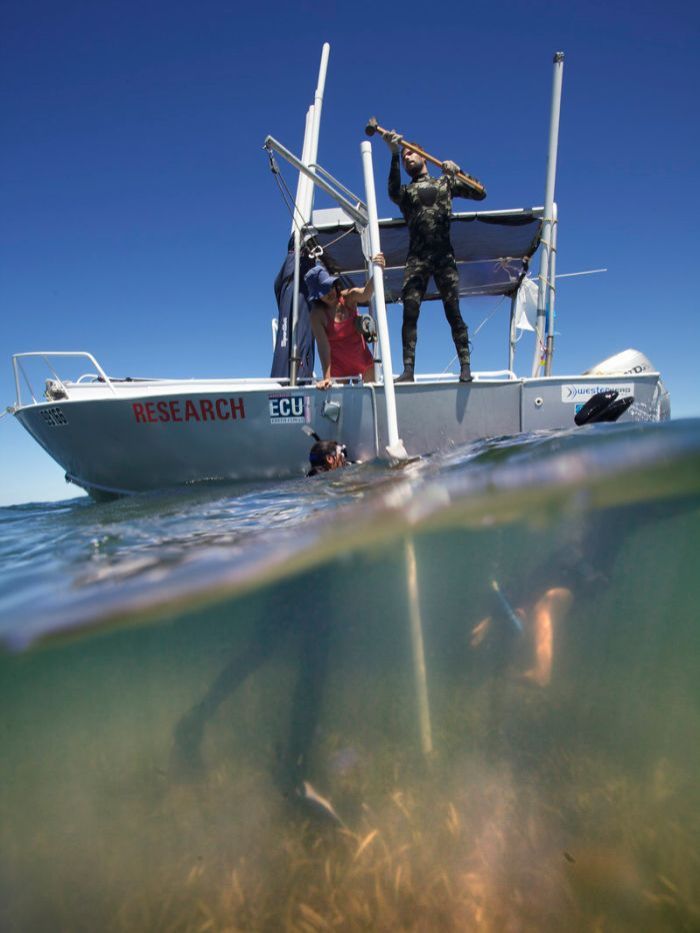 |
| An international research team at Shark Bay in 2018. (Image: Joan Costa) |
Dr Shaw authored: Decommissioning offshore infrastructure: a review of stakeholder views and science priorities, in 2018 under WA’s Blueprint for Marine Science 2050 priorities. The WAMSI decommissioning report synthesised more than 900 issues, opportunities and concerns down to 30 questions that could be addressed through scientific research. The review has been identified as a key resource for oil and gas research.
Links to related stories on Shark Bay:
Shark Bay: A World Heritage Site at catastrophic risk (The Conversation, Feb 2019)
Growing movement to highlight Shark Bay climate risks (WAMSI, September 2018)
Adapting to ecosystem change in the Shark Bay World Heritage site (WAMSI, June 2018)
Adapting to ecosystem change in the Shark Bay World Heritage Site (Workshop presentations, June 2018)
Shark Bay seagrass loss during ocean heatwave released up to 9m tonnes of CO2, scientists say (ABC, March 2018)
Will Shark Bays seagrass survive big floods? (ECOS – 2011)
